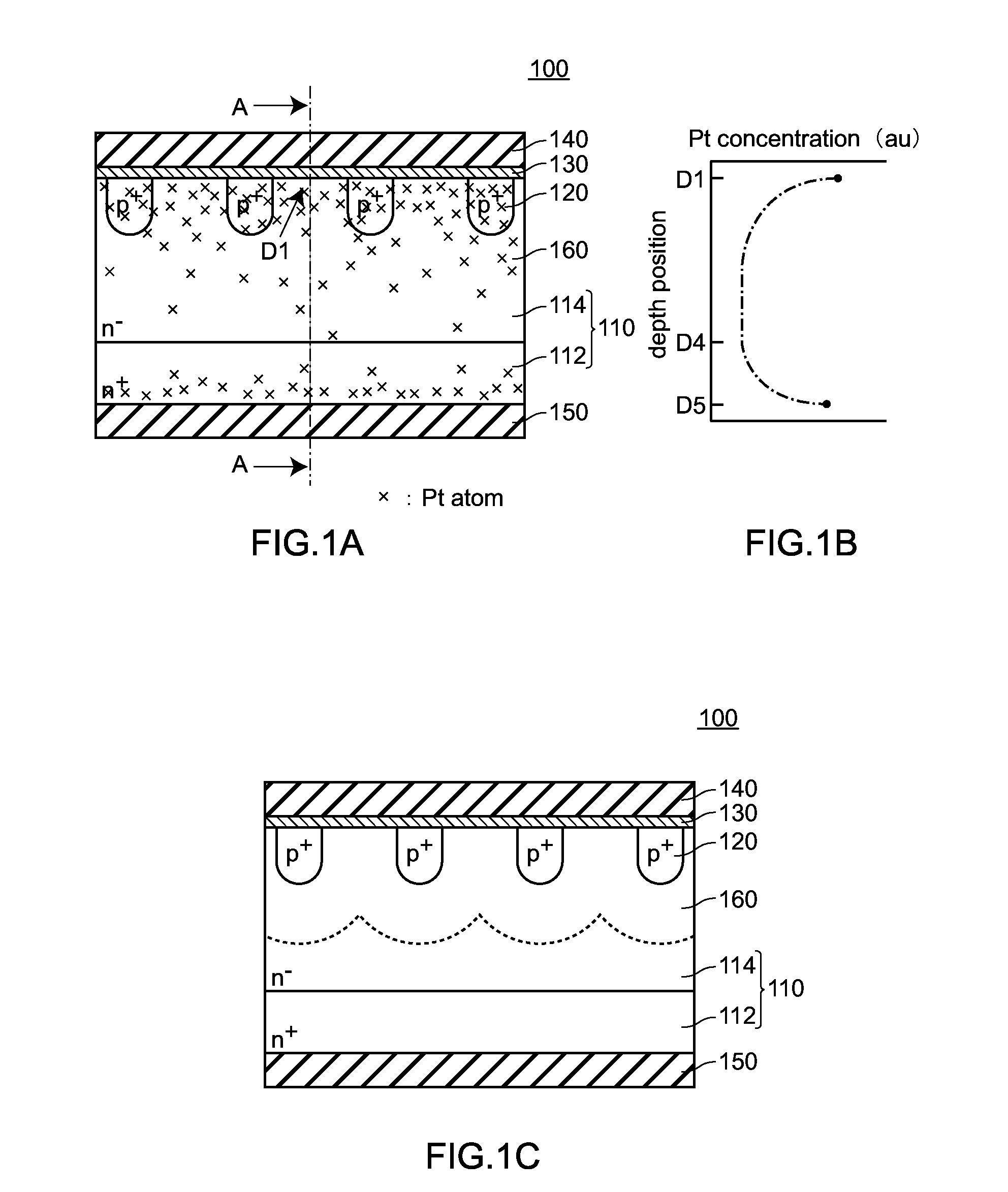Semiconductor device
a technology of mikro-conductor and reverse withstand voltage, which is applied in the direction of mikro-conductor devices, basic electric elements, electrical appliances, etc., can solve the problems of not easy to the reverse withstand voltage vr is lowered, and the reverse withstand voltage vr is not easy to lower. vf or shorten the reverse recovery time trr, etc., to achieve the effect of lowering the leak current ir
- Summary
- Abstract
- Description
- Claims
- Application Information
AI Technical Summary
Benefits of technology
Problems solved by technology
Method used
Image
Examples
embodiment 1
A. Semiconductor Device 100 According to Embodiment 1
[0046]FIG. 1A to FIG. 1C are views for explaining a semiconductor device 100 according to the embodiment 1. FIG. 1A is a cross-sectional view of the semiconductor device 100, FIG. 1B is a graph showing the concentration distribution of heavy metal (platinum) in a semiconductor base body 110, and FIG. 1C is a view showing a state where a depletion layer 160 extends when a reverse bias is applied to the semiconductor device 100.
[0047]As shown in FIG. 1, the semiconductor device 100 according to the embodiment 1 includes: a semiconductor base body 110 having the structure where an n+-type semiconductor layer (a first semiconductor layer of a first conductive type) 112 and an n−-type semiconductor layer (a second semiconductor layer of a first conductive type) 114 containing an impurity of an n-type (an impurity of a first conductive type) at a concentration lower than a concentration of the impurity of the first conductive type conta...
modification 1
[Modification 1]
[0081]FIG. 5A to FIG. 5D are views for explaining a method of manufacturing a semiconductor device according to a modification 1 of the embodiment 1. FIG. 5A to FIG. 5D are views showing respective steps of the method. In the method of manufacturing a semiconductor device according to the modification 1 of the embodiment 1, steps following a heavy metal diffusion source layer forming step (see FIG. 3D to FIG. 4D) are substantially equal to the corresponding steps in the method of manufacturing a semiconductor device according to the embodiment 1 and hence, the illustrations of the steps corresponding to the steps shown in FIG. 3D to FIG. 4D are omitted.
[0082]Although the method of manufacturing a semiconductor device according to the modification 1 of the embodiment 1 basically includes the substantially same steps as the method of manufacturing a semiconductor device according to the embodiment 1, the modification 1 differs from the embodiment 1 with respect to a ty...
modification 2
[Modification 2]
[0085]FIG. 6A and FIG. 6B are views for explaining a method of manufacturing a semiconductor device according to a modification 2 of the embodiment 1. FIG. 6A and FIG. 6B are views showing respective steps of the method. FIG. 7A and FIG. 7B are views for explaining a semiconductor device 100b according to the modification 2 of the embodiment 1. FIG. 7A is a cross-sectional view of the semiconductor device 100b, and FIG. 7B is a graph showing the concentration distribution of heavy metal (platinum) in the semiconductor base body 110. In the method of manufacturing a semiconductor device according to the modification 2 of the embodiment 1, steps up to a heavy metal diffusion source layer forming step (see FIG. 3A to FIG. 3C) and steps following a barrier metal layer forming step (see FIG. 4C to FIG. 4D) are substantially equal to the corresponding steps in the method of manufacturing a semiconductor device according to the embodiment 1 and hence, the illustrations of t...
PUM
 Login to View More
Login to View More Abstract
Description
Claims
Application Information
 Login to View More
Login to View More - R&D
- Intellectual Property
- Life Sciences
- Materials
- Tech Scout
- Unparalleled Data Quality
- Higher Quality Content
- 60% Fewer Hallucinations
Browse by: Latest US Patents, China's latest patents, Technical Efficacy Thesaurus, Application Domain, Technology Topic, Popular Technical Reports.
© 2025 PatSnap. All rights reserved.Legal|Privacy policy|Modern Slavery Act Transparency Statement|Sitemap|About US| Contact US: help@patsnap.com



